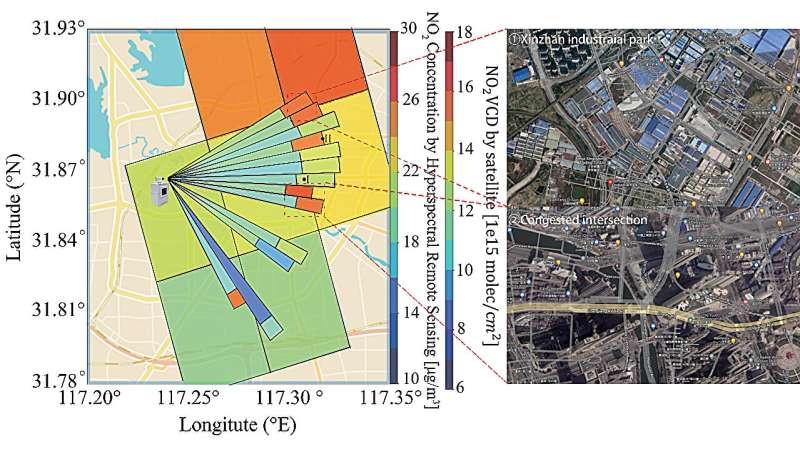This article has been reviewed according to Science X's editorial process and policies. Editors have highlighted the following attributes while ensuring the content's credibility:
fact-checked
proofread
Advanced hour-hectometer hyperspectral remote sensing for fine-scale atmospheric emissions

A groundbreaking study by researchers from a number of institutions in China introduces a novel hyperspectral remote sensing technique capable of hour-hectometer level horizontal distribution of trace gases, offering an advanced tool to accurately identify emission sources.
The study was published in the Journal of Remote Sensing on 14 November 2023.
The research introduces a groundbreaking hyperspectral remote sensing method that delivers highly accurate, hour-hectometer-level insights into the horizontal distribution of atmospheric trace gases. This advanced technique utilizes effective optical paths (EOPs) within the ultraviolet (UV) and visible (VIS) spectral bands to measure average trace gas concentrations across various distances.
A novel aspect of the study is the application of the onion-peeling method, which further refines the data to reveal concentrations at specific distances, offering unprecedented detail and accuracy.
The method represents a significant improvement over traditional satellite and in-situ monitoring techniques, often constrained by spatial and temporal resolution. In practical applications, this technique successfully pinpointed small yet critical high-value emission areas in Hefei, China, demonstrating its potential for detailed environmental monitoring and urban planning. It also highlighted the limitations in satellite data's ability to represent daily average concentrations, indicating the need for a reevaluation of current emission inventories.
This research not only enhances our understanding of atmospheric pollutants and their distribution but also provides a powerful tool for more targeted pollution control strategies and environmental policymaking.
The researcher Chuan Lu emphasizes, "This new method significantly outperforms existing ones in terms of spatial and temporal resolution, offering a detailed insight into the horizontal distribution of trace gases and enabling more accurate identification of high-value emission areas."
This technique offers valuable insights into urban pollution hotspots and aids in identifying high-value emission areas, which are crucial for urban planning and public health. It enhances the reliability of bottom-up emission calculations and informs strategies for pollution control and mitigation.
The method's capacity to provide higher resolution in emission source detection paves the way for more targeted and effective environmental policies and interventions. Its application has the potential to revolutionize our understanding of emission sources and contribute significantly to global efforts in pollution control and environmental protection.
More information: Chuan Lu et al, A Novel Hyperspectral Remote Sensing Technique with Hour-Hectometer Level Horizontal Distribution of Trace Gases: To Accurately Identify Emission Sources, Journal of Remote Sensing (2023). DOI: 10.34133/remotesensing.0098
Provided by TranSpread




















